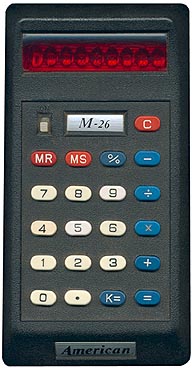
The American M-26 was an inexpensive LED calculator that hit the market around 1975-1976. With its all-plastic case and limited functionality, it exemplified the low-end calculators that became widely available to consumers in the mid-1970s.
The M-26 had a compact but chunky profile, measuring approximately 63mm x 115mm x 30mm (w,h,d). It was powered by a single 9V battery and did not have an AC adapter jack. The case was made of black plastic with a tilted red plastic display filter to enhance visibility of the 8-digit LED display.
Inside, the M-26 had simple circuitry consisting of a main CPU chip, a display driver chip, and an 8-digit red LED display module. It offered only basic four function arithmetic, percentages, a constant function, and two memory registers. The tiny plastic keys had a short, bouncy travel, similar to early keyboards from Commodore.

Despite its low price, the M-26 suffered from multiple flaws in its underlying math logic. It could not properly handle negative numbers or decimals. Known bugs included a “negative zero” error, loss of the negative sign on overflow, and lack of recovery from divide by zero or overflow conditions. The percentage key simply divided by ten repeatedly, often turning negative numbers positive in the process.
Overall, the M-26 represented the affordable end of 1970s LED calculators. While useful for simple math, its faults highlight how cheap manufacturing led to major limitations and errors even in basic calculation abilities. For collectors, the M-26 is an interesting example of how early electronic calculators balanced cost and functionality. Its quirks also provide a case study in the progress of calculator logic and capabilities over just a few years of rapid development.